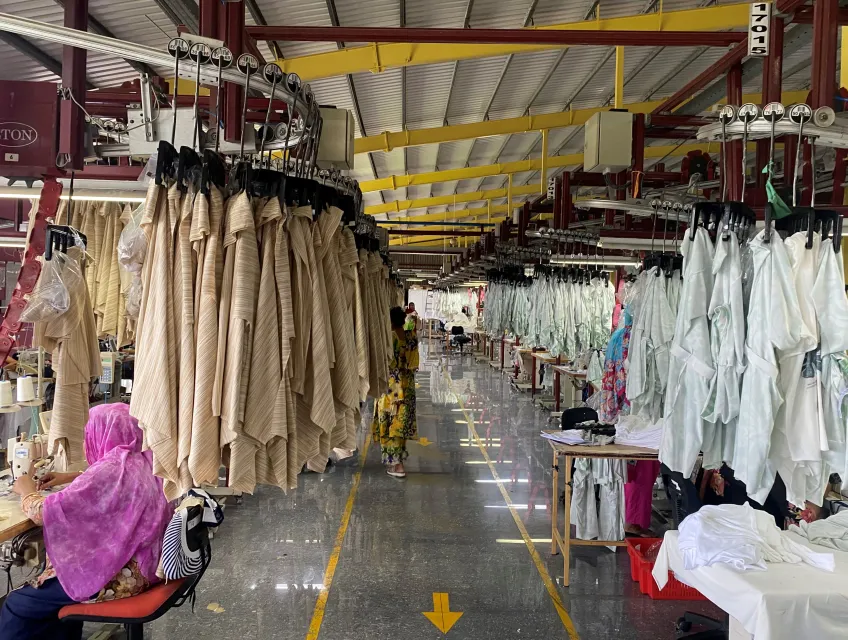The African island nation of Mauritius is often highlighted as a success story in terms of economic development. Today, the country boasts the second-highest GDP per capita in Africa and managed to lift itself out of widespread poverty by investing in export-oriented garment manufacturing as early as the 1970s. But what has happened during the half-century since then? To what extent has this growth been accompanied by social sustainability?
As a doctoral candidate at the Agenda 2030 Graduate School and the School of Economics and Management at Lund University, Linn Ternsjö set out to investigate these questions. Her aim was to study how Mauritius’ economic success has impacted the conditions of workers in the textile and garment industry, with a particular focus on gender, migration and sustainable development. To gain an interdisciplinary understanding of the situation, she combined quantitative data and documentary analysis with extensive fieldwork.
Linn Ternsjö spent several months living in Mauritius, socialising with factory workers to hear their voices unfiltered. In total, she interviewed 54 people – both men and women, locals as well as migrant workers – in occupational roles ranging from factory-floor seamstresses to boardroom executives.
‘I spent weekends outside the factories talking to employees, eating street food in their neighbourhoods and hanging out in the small grocery shop where many bought their essentials. It was a way to make contact and to understand life beyond the workplace,’ says Linn Ternsjö.
Migrant workers absent in the surveys
By combining macroeconomic data and household survey data with fieldwork and secondary sources, she was able to trace how working conditions have been affected by the country’s economic development and political economy. Initially, Linn Ternsjö intended to approach the research through a gender lens, but revised that plan after arriving in Mauritius. On her first visit, she was surprised by the composition of the factory workforce. There was a stark contrast between the official data and what she observed in reality.
‘I had access to a wealth of official data, including wage statistics and household survey data in Mauritius. But it turned out that migrant workers were entirely absent from these household surveys, despite male migrants making up about half of the workforce in a typical textile and garment factory.’
According to Linn Ternsjö, women from Mauritius made up most of the other half, and differences in working conditions were more closely tied to nationality and citizenship than to gender. Migrant workers lived in cramped dormitories near the factories, often worked overtime, and conducted most of their lives there, whereas Mauritian women returned to their families after work and typically took on household responsibilities.
So what were the working conditions like? As a master’s student, Linn Ternsjö had visited textile workers in Ethiopia, and in comparison, wages and working conditions were substantially better in Mauritius – which is not surprising given the country’s more advanced economic development. The minimum wage was also significantly increased in Mauritius five years ago. Migrant workers, however, earned considerably less than the local population, a discrepancy often justified by the fact that they received food and accommodation as part of their employment.
Production of European garments
Nowadays, Mauritius primarily produces European branded cotton garments, where slightly higher prices can be tolerated than in the budget segment.
‘It still involves long working days, six to seven days a week, and repetitive, high-paced work – for instance, sewing 300 seams in an hour. A second income in the household is necessary to get by. But Mauritius has avoided major scandals, and companies must maintain a certain standard to retain both staff and international customers,’ says Linn Ternsjö.
Although the country has experienced economically favourable development and several factories have managed to increase the value of their production by learning to manufacture more complex and higher-margin textiles and garments, Ternsjö argues that the benefits have been unevenly distributed. The improvements in the garment industry have largely been aimed at increasing the local sector’s resilience and reputation rather than improving workers’ conditions.
There are also significant wage disparities between the sexes, partly because women are entirely absent from leadership positions. A clear hierarchy exists in which women hold lower-paid roles in the factories, while migrants – many of whom are from Bangladesh – have the lowest status and social standing.
At the same time, Mauritius faces structural vulnerabilities: when a country builds its prosperity on a low-wage sector, there is a high risk that jobs will eventually relocate to a country with even lower costs.
‘Mauritius has failed to sufficiently raise the education and skills levels so that the workforce can transition into other growing sectors. A labour-intensive industry like garments can be a good starting point, but it’s crucial to also plan for the future so that people can access better and more qualified jobs over time. If a particular group lacks both skills and real alternatives – even after the economy has diversified – their ability to organise and demand better working conditions and higher wages is also limited.’
Requires strategic policies
Linn Ternsjö hopes that her research can offer a more nuanced view of export-oriented garment manufacturing as a straightforward path to industrialisation and inclusive socio-economic development for low-income countries. There are multiple pros and cons that require strategic domestic social and economic policy. For example, it is advantageous (though challenging) to invest in multiple sectors to make the economy less vulnerable to low-wage competition and market fluctuations. But even when a sector like the clothing industry, and the wider economy, is relatively successful, its workers – particularly women and migrants – are likely to continue to lose out.
‘In this study, I wasn’t able to explore sustainability from an environmental perspective, but it would have been extremely interesting to do so. The clothing and textile industry also faces enormous challenges in that area,’ she adds.
Read more about Linn Ternsjö
Read Linn Ternsjö's thesis Garment Workers and the Labour Issue in Development: The Case of Mauritius – portal.research.lu.se



